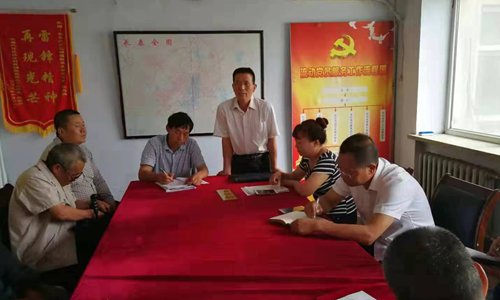
The Party branch for the migrant population in Changchun, Northeast China's Jilin Province, holds a meeting to discuss a new waste recycling project on April 12, 2018. (Photo: Global Times)
Behind a green door in a building in Changchun, Northeast China's Jilin Province, sits China's first branch of the Communist Party of China (CPC) serving waste disposal workers.
Established in 2005 by Jiang Shun, a Party member from Central China's Henan Province, who collected waste for living, the branch has developed into a 115-member committee with six sub-Party-branches that cover over 10,000 migrant workers in the city.
"Our Party branch is growing stronger," Jiang told the Global Times, "We also established a migrant population association to better serve them."
The Party branch helps a lot of migrant workers find re-employment through the association. "70 percent of members of the association work in waste recycling and processing, and the other 30 percent are in other industries such as catering, building and selling cars," he added.
The branch also helps migrant workers with difficulties. When one migrant worker broke his arm in an accident, the branch organized a donation and collected over 100,000 yuan ($14,902) for him, Jiang said.
Jiang Shun, who joined the CPC in Henan in 1994, collected scrap in Changchun for living, and because of the hard life, he lost contact with the Party.
"I felt lonely when I left my hometown, and I had no sense of direction in Changchun," Jiang recalled his life before reconnecting with the Party. "Coming back to the Party organization gave me spiritual support and direction." Jiang reconnected with the Party in the Party branch of Jincheng street in 2005.
After resuming Party activities, Jiang led other migrant Party members to attend the education on Party member's progressiveness. In August 2005, the first Party branch serving waste disposal workers was established, and Jiang was elected its secretary.
Members of migrant population association, who come from nine provinces, have now surpassed 8,000 in number, and the association has benefited thousands of families.
Jiang's story was adapted into a film called Jiang Shun Comes Back Home, which was produced by the organization department of Henan's provincial committee of the CPC in 2005.
Su Wei, a professor at the Party School of the CPC Chongqing Municipal Committee, told the Global Times that the establishment of a Party branch for waste disposal workers is in accordance with the Party Constitution, since it stipulates that a grass-roots Party organization shall be formed wherever there are three or more Party members.
Additionally, full-coverage of grass-roots Party organizations has long been a requirement of Party building, said Su.
Innovative Party building
The first Party branch in a commercial building in Shanghai was established on May 26, 2002, by the Party committee of Jing'ansi street of the city, kicking off a new Party building model, according to people.cn.
In 1999, a total of 130,000 newly emerged economic entities were established in Shanghai with more than one million employees, including a large number of migrant CPC members. Party building in these entities had been lacking, making it difficult for active young people to join the Party at that time.
According to the report, as of the end of 2017, a total of 521 Party branches were established in 185 buildings in Jing'an district, incorporating 7,265 Party members.
This new type of Party organizations has become prevalent and adopted by cities across China.
A Party branch was established in Xinglong Plaza in Changsha, Central China's Hunan Province on November 5, 2016.
Li Na, a Party member who works in the plaza, said since the establishment of the Party branch in the building, she no longer rushes home after work. Instead, she grabs a book or chats with others at the Party member activity center. "It feels like a home."
Su saw the new types of Party branches as a creation the CPC has come up with to adapt to social development. "The Chinese society is undergoing dramatic changes, including the migration and vocational stratification among members of society and the Party."
"Grass-roots Party organizations should be flexible in terms of forms and activities," said Su.
Su also believes the innovation the CPC has made is to cater more young people's wishes to join the Party.
Since the 18th National Congress of the CPC, a collection of conduct problems within the Party has been corrected. Party cohesion has become stronger, attracting young people to make contributions with its remarkable achievements made as the country's governing Party, said Su.


